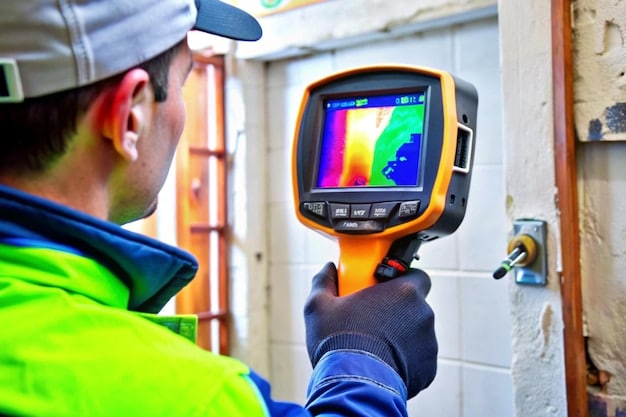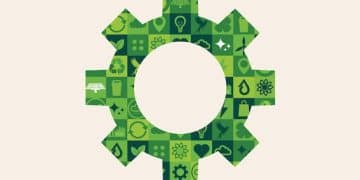Energy Costs Surge: Smart Ways for Businesses to Cut Expenses by 20%

Facing rising energy costs, businesses can implement efficiency measures like upgrading to LED lighting, improving insulation, and using smart thermostats to potentially reduce expenses by up to 20%.
As businesses grapple with soaring energy prices, finding effective strategies to reduce expenses is crucial for maintaining profitability and competitiveness. This article explores practical efficiency measures that can help businesses slash their energy bills by up to 20%.
Understanding the Impact of Rising Energy Costs on Businesses
The current economic climate presents significant challenges for businesses across various sectors. Among the most pressing concerns are the escalating energy costs, which directly impact operational expenses and bottom lines. Understanding the causes and consequences of these rising costs is the first step towards finding effective solutions.
Businesses must recognize that energy efficiency is not merely a cost-saving measure but a strategic imperative for long-term sustainability. By proactively addressing energy consumption, companies can enhance their financial stability, reduce their environmental footprint, and even improve their brand image.
Factors Contributing to Energy Cost Increases
Several factors contribute to the recent surge in energy costs. Geopolitical instability, supply chain disruptions, and increasing demand have all played a role. Additionally, the transition towards renewable energy sources, while essential for environmental reasons, can sometimes lead to short-term price volatility.
- Geopolitical Tensions: Conflicts and political instability in key energy-producing regions can significantly disrupt supply chains and drive up prices.
- Supply Chain Disruptions: Events such as natural disasters or logistical bottlenecks can limit the availability of energy resources, leading to increased costs.
- Growing Demand: As economies grow and populations increase, the demand for energy rises, putting upward pressure on prices.
- Renewable Energy Transition: The shift towards renewable energy sources requires significant investment and infrastructure development, which can impact energy prices in the short term.
Ultimately, companies must be aware of these factors and proactively adapt their energy management strategies to mitigate their impact. By analyzing their energy consumption patterns and identifying areas for improvement, businesses can make informed decisions and implement effective cost-saving measures.
Conducting an Energy Audit: The First Step Towards Efficiency
Before implementing any energy-saving measures, it’s essential to understand your current energy usage. A thorough energy audit provides a detailed analysis of your energy consumption patterns, identifies areas of inefficiency, and recommends specific improvements. This audit serves as the foundation for developing a targeted and effective energy management plan.
An energy audit can be conducted internally by a trained staff member or externally by a professional energy auditor. The choice depends on the complexity of your operations and the level of detail required. Regardless of the approach, the key is to gather accurate data and analyze it systematically.

What to Expect During an Energy Audit
An energy audit typically involves a comprehensive assessment of your building’s energy systems, including heating, cooling, lighting, and equipment. The auditor will collect data on energy consumption, building characteristics, and operational practices. They will then analyze this data to identify areas where energy is being wasted and recommend specific improvements.
The audit report should include detailed recommendations for energy-saving measures, along with estimates of their potential cost savings and payback periods. This information will help you prioritize investments and make informed decisions about which measures to implement first.
- Data Collection: Gathering information on energy bills, equipment specifications, and building characteristics.
- On-Site Inspection: Examining the building’s energy systems and identifying areas of inefficiency.
- Data Analysis: Analyzing the collected data to identify energy consumption patterns and potential savings.
- Report Generation: Preparing a detailed report with recommendations for energy-saving measures and their estimated cost savings.
By following recommendations from a thorough energy audit, businesses can gain a clear understanding of their energy usage and start to implement strategies to reduce costs.
Lighting Up Savings: Switching to LED Technology
One of the most straightforward and effective ways for businesses to reduce energy costs is to upgrade their lighting systems to LED (Light Emitting Diode) technology. LED lighting offers significant energy savings compared to traditional incandescent or fluorescent lighting, along with numerous other benefits.
The initial investment in LED lighting may be higher, but the long-term cost savings and performance advantages make it a worthwhile investment. LEDs consume significantly less energy, last much longer, and produce a higher quality of light.
Benefits of LED Lighting
LED lighting offers a wide range of benefits, making it an attractive option for businesses looking to reduce energy costs and improve their lighting quality. These benefits include:
- Energy Efficiency: LEDs consume up to 75% less energy than traditional incandescent or fluorescent lighting.
- Long Lifespan: LEDs can last up to 25 times longer than traditional lighting, reducing the need for frequent replacements.
- Improved Light Quality: LEDs produce a brighter, more consistent, and more natural-looking light.
- Reduced Maintenance Costs: With their long lifespan, LEDs require less frequent maintenance and replacement, saving time and money.
In addition to the direct cost savings, LED lighting can also improve the overall ambiance and appearance of your business, creating a more welcoming and productive environment. As such, switching to LED can be an effective way to improve both cost-effectiveness and general atmosphere.
HVAC Optimization: Improving Heating and Cooling Efficiency
Heating, ventilation, and air conditioning (HVAC) systems are among the most significant energy consumers in many businesses. Optimizing these systems is crucial for reducing energy costs and improving overall efficiency. Regular maintenance, upgrades, and smart controls can all contribute to significant savings.
Businesses can minimize energy waste and save money by improving HVAC systems. Regular maintenance can help maximize lifetime, improve efficiency, and more.

Strategies for HVAC Optimization
There are several strategies businesses can implement to optimize their HVAC systems and reduce energy consumption. These strategies include:
- Regular Maintenance: Schedule regular maintenance checks to ensure your HVAC systems are running efficiently. This includes cleaning filters, inspecting ductwork, and calibrating thermostats.
- Smart Thermostats: Install smart thermostats that automatically adjust the temperature based on occupancy and time of day. These can be programmed to reduce energy consumption during off-peak hours.
- Upgrades: Consider upgrading to energy-efficient HVAC equipment with high SEER (Seasonal Energy Efficiency Ratio) and HSPF (Heating Seasonal Performance Factor) ratings.
- Proper Insulation: Ensure your building is properly insulated to minimize heat loss in the winter and heat gain in the summer, reducing the workload on your HVAC systems.
Implementing these strategies can result in significant energy savings and contribute to a more comfortable and productive work environment.
Smart Building Technologies: Automating Energy Management
Smart building technologies offer advanced solutions for automating and optimizing energy management. These technologies use sensors, data analytics, and machine learning to monitor energy consumption, identify inefficiencies, and automatically adjust building systems for optimal performance. Investing in smart building technologies can lead to substantial energy savings and improved operational efficiency.
Investing in smart building technologies, such as automated lighting and temperature controls, can significantly reduce energy waste. These systems often pay for themselves through savings within a few years.
Examples of Smart Building Technologies
There are several smart building technologies available on the market, each offering unique solutions for energy management. Some examples include:
- Smart Lighting Controls: Automatically adjust lighting levels based on occupancy and ambient light, reducing energy consumption in unoccupied areas.
- Smart HVAC Controls: Optimize HVAC system performance based on occupancy, weather conditions, and energy prices, maximizing efficiency and minimizing costs.
- Energy Monitoring Systems: Provide real-time data on energy consumption, allowing businesses to identify areas of inefficiency and track the effectiveness of energy-saving measures.
By leveraging these systems, businesses can create a more sustainable and energy-efficient environment. With smart building technologies, you can optimize your energy management system to reduce your environmental impact and your spending.
Employee Engagement: Fostering a Culture of Energy Conservation
While technological solutions are essential, employee engagement is equally important for achieving significant energy savings. Encouraging employees to adopt energy-conscious behaviors can create a culture of conservation and amplify the impact of other efficiency measures. Simple actions, such as turning off lights, powering down equipment, and reporting energy waste, can add up to substantial savings over time.
Businesses can significantly reduce energy consumption by fostering a culture of energy saving, even with small actions such as turning off lights.
Strategies for Employee Engagement
There are several strategies businesses can use to engage employees and promote energy conservation. These strategies include:
- Education and Training: Provide employees with education and training on energy-saving practices and the importance of conservation.
- Incentive Programs: Implement incentive programs that reward employees for identifying and implementing energy-saving ideas.
- Communication Campaigns: Launch communication campaigns to raise awareness of energy consumption and promote energy-saving behaviors.
By engaging employees and fostering a culture of energy conservation, businesses can take meaningful steps towards reaching efficiency goals.
| Key Point | Brief Description |
|---|---|
| 💡 LED Lighting | Switching to LED lights reduces energy consumption and lifecycle costs. |
| 🌡️ HVAC Optimization | Improving heating and cooling efficiency saves energy and money. |
| 📊 Energy Audits | Identifying energy waste areas to cut costs effectively. |
| 🌱 Employee Engagement | Encouraging sustainable habits among employees. |
Frequently Asked Questions
▼
It’s recommended to conduct a comprehensive energy audit every 3-5 years to identify new opportunities for energy savings and ensure that your systems are operating efficiently.
▼
The initial cost for switching to LED lights can be higher than traditional lighting, but the long-term energy savings and reduced maintenance costs make it a worthwhile investment.
▼
Smart thermostats help save energy by automatically adjusting the temperature based on occupancy and time of day, ensuring that energy is not wasted heating or cooling unoccupied spaces.
▼
Yes, simple actions like turning off lights, powering down equipment, and reporting energy waste can add up to substantial savings over time, especially when practiced by all employees.
▼
Many government incentives, such as tax credits and rebates, are available for businesses that invest in energy-efficient technologies and practices. Check with your local and national energy agencies for details.
Conclusion
In conclusion, rising energy costs pose a significant challenge for businesses, but they also present an opportunity to improve efficiency and reduce expenses. By conducting energy audits, upgrading to LED lighting, optimizing HVAC systems, adopting smart building technologies, and engaging employees, businesses can significantly reduce their energy consumption and achieve substantial cost savings. Taking these steps can not only improve your bottom line but also contribute to a more sustainable future.





